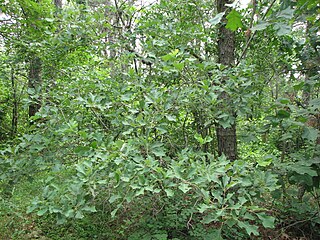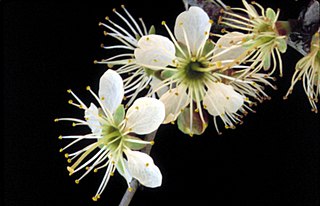
The longleaf pine is a pine species native to the Southeastern United States, found along the coastal plain from East Texas to southern Virginia, extending into northern and central Florida. In this area it is also known as "yellow pine" or "long leaf yellow pine", although it is properly just one out of a number of species termed yellow pine. It reaches a height of 30–35 m (98–115 ft) and a diameter of 0.7 m (28 in). In the past, before extensive logging, they reportedly grew to 47 m (154 ft) with a diameter of 1.2 m (47 in). The tree is a cultural symbol of the Southern United States, being the official state tree of Alabama. This particular species is one of the eight pine tree species that falls under the "Pine" designation as the state tree of North Carolina.

Pinus rigida, the pitch pine, is a small-to-medium-sized pine. It is native to eastern North America, primarily from central Maine south to Georgia and as far west as Kentucky. It is found in environments which other species would find unsuitable for growth, such as acidic, sandy, and low-nutrient soils.

Pinus serotina, the pond pine, black bark pine, bay pine,marsh pine, or pocosin pine, is a pine tree found along the Southeastern portion of the Atlantic coastal plain of the United States, from southern New Jersey south to Florida and west to southern Alabama. Pond pine distribution may be starting to spread west towards Mississippi and Tennessee.

Jack pine, also known as grey pine or scrub pine, is a North American pine.

The Atlantic coastal pine barrens is a now rare temperate coniferous forest ecoregion of the Northeast United States distinguished by unique species and topographical features, generally nutrient-poor, often acidic soils and a pine tree distribution once controlled by frequent fires.

Pine barrens, pine plains, sand plains, or pineland areas occur throughout the U.S. from Florida to Maine as well as the Midwest, West, and Canada and parts of Eurasia. Perhaps the most well known pine-barrens area to North Americans is the New Jersey Pine Barrens. Pine barrens are generally pine forests in otherwise "barren" and agriculturally challenging areas. Such pine forests often occur on dry, acidic, infertile soils, and also include grasses, forbs, and low shrubs. The most extensive pine barrens occur in large areas of sandy glacial deposits, lakebeds, and outwash terraces along rivers.

Adenostoma fasciculatum, commonly known as chamise or greasewood, is a flowering plant native to California and Baja California. This shrub is one of the most widespread plants of the California chaparral ecoregion. Chamise produces a specialized lignotuber underground and at the base of the stem, known as a burl, that allow it to resprout after fire has off burned its stems. It is noted for its greasy, resinous foliage, and its status as one of California's most iconic chaparral shrubs.

Coleogyne ramosissima or blackbrush, is a low lying, dark grayish-green, aromatic, spiny, perennial, soft wooded shrub, native to the deserts of the southwestern United States. It is called blackbrush because the gray branches darken when wet by rains. It is in the rose family (Rosaceae), and is the only species in the monotypic genus Coleogyne.

Rhus copallinum, the winged sumac, shining sumac, dwarf sumac or flameleaf sumac, is a species of flowering plant in the cashew family (Anacardiaceae) that is native to eastern North America. It is a deciduous tree growing to 3.5–5.5 metres (11–18 ft) tall and an equal spread with a rounded crown. A 5-year-old sapling will stand about 2.5 metres (8.2 ft).

The Batona Trail is a 53.5-mile (86.1 km) hiking trail through New Jersey's Pine Barrens. The trail is one of the longest in the state, behind the Delaware and Raritan Canal Trail, the section of the Appalachian Trail within the state, the Liberty-Water Gap Trail, and the completed section of the Highlands Trail in the state. The Batona Trail begins in Brendan T. Byrne State Forest at the ghost town of Ong's Hat and traverses Franklin Parker Preserve, Wharton State Forest and Bass River State Forest. The trail was built in 1961 by the Batona Hiking Club, which began informally in 1928 when Philadelphians began meeting regularly to hike. It takes about three days to hike the whole trail.

Quercus ilicifolia, commonly known as bear oak or scrub oak, is a small shrubby oak native to the Eastern United States and, less commonly, in southeastern Canada. Its range in the United States extends from Maine to North Carolina, with reports of a few populations north of the international frontier in Ontario. The name ilicifolia means "holly-leaved."

Prunus geniculata is a rare species of plum known by the common name scrub plum. The species is endemic to Florida.

Rhynchospora knieskernii is a rare species of sedge known by the common name Knieskern's beaksedge. It is endemic to the state of New Jersey in the United States, where it occurs naturallyin the Pine Barrens. Reports have cited it present in Delaware as well, but these populations appear to have been introduced. It is threatened by the destruction and degradation of its habitat. It is a federally listed threatened species of the United States.

Artemisia rigida is a species of flowering plant in the aster family known by the common names scabland sagebrush and stiff sagebrush. It is native to the northwestern United States, in Washington, Idaho, and Oregon. It has been recorded in western Montana but these sightings may have been misidentifications.

Hudsonia ericoides is a species of flowering plant in the rock-rose family known by the common names pine barren goldenheather, false heather, and golden-heather. It is native to eastern North America, where its distribution extends down the east coast from Newfoundland to Delaware, with a disjunct population in South Carolina.

Smilax laurifolia is a species of flowering plant in the greenbrier family known by the common names laurel greenbrier, laurelleaf greenbrier, bamboo vine, and blaspheme vine. It is native to the southeastern United States, where it occurs along the Gulf and Atlantic coastal plains from Texas to New Jersey, the range extending inland to Arkansas, Oklahoma, and Tennessee. It also occurs in Cuba and the Bahamas.

Carex barrattii is a species of sedge known as Barratt's sedge. It is endemic to the United States, where it occurs on the Atlantic Coastal Plain from Connecticut south to Georgia and Alabama. It also occurs in the southern Appalachians.

Corema is a genus of two species of flowering plants in the family Ericaceae. They are dioecious small shrubs.

Hilaria rigida is a species of clumping perennial grass that is widespread in California deserts. It is commonly known as big galleta. It is a monocot in the Hilaria genus of the grass family (Poaceae).

Corema album, the Portuguese crowberry ; Spanish: camarina, is a species of flowering plant in the family Ericaceae endemic to the Iberian Peninsula, Aquitaine, and the Azores (sub-species), where it may also be considered a different species. Its white berries are known to have been consumed by people in the Iberian Peninsula at least since the Middle-Ages. The only other species of the same genus is Corema conradii, found in North America.



















